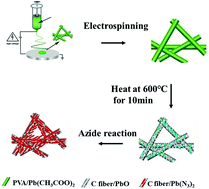Fabrication of a nanoscale homogeneous lead azide@carbon fiber film with low electrostatic sensitivity by in situ synthesis
Abstract
In this work, a nanoscale carbon-based lead azide explosive film was prepared by electrospinning, carbonization, in situ azidation reactions, and other steps using cheap and easily available lead acetate as the raw material. Nanoscale lead azide particles are uniformly grown on the surface of the carbon fiber, and the excellent electrical conductivity of the carbon fiber can reduce its electrostatic sensitivity. Through scanning electron microscopy (SEM), Fourier transform infrared spectroscopy (FT-IR), X-ray diffraction (XRD), the specific Brunauer–Emmett–Teller (BET) surface area analysis, and thermogravimetric analysis (TG), the precursor materials, carbide intermediates, and lead azide@carbon fiber (LA@CF) were all characterized in detail. The test results show that due to the excellent electrical and thermal conductivity of the carbon fiber, the electrostatic sensitivity of the prepared lead azide film is reduced to 1.5 J, and the flame sensitivity is increased to 35 cm. Compared with powder materials, LA@CF films can reduce the accidental explosion caused by the particle friction of film-like primary explosives. This paper also provides a new idea for the preparation of nanoscale LA by in situ synthesis.



 Please wait while we load your content...
Please wait while we load your content...